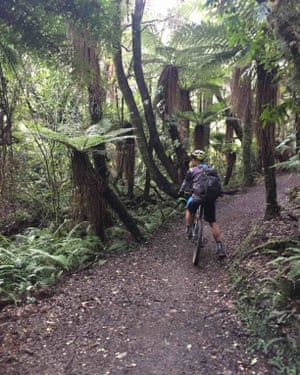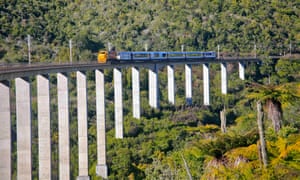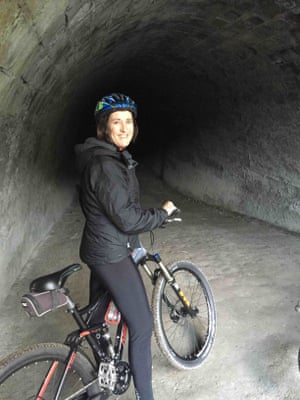When you haven’t been on a bicycle for four years – and the reason is because last time you were cycling, you fell off, broke your shoulder bone clean in half and have been slightly traumatised by the sight of bicycles ever since – is it wise to sign up for a 15km mountain bike ride?
When you were never much of a cyclist anyway? And you have never been on a mountain bike, or cycled on anything other than lovely smooth bikeways? And you don’t really understand how gears work?
Don’t bother answering, I know the answer, but I went ahead and did it anyway.
To be fair to my idiotic self, I wasn’t entirely clear on the fact it was a mountain bike ride on the side of an actual mountain: I briefly looked at the lovely brochure photos of people cycling along a flat road in a gorgeous landscape and said “Yes”, as per my 2017 resolution to say yes to all excellent opportunities.
It was worth the post-traumatic stress. On the Old Coach Road near Ohakune, New Zealand, you will see all sorts of glory – if your breath is not taken by the cycling, it will be by the extraordinary peace and beauty.

I’ve been transported to the middle Earth-ish middle of the North Island by the Northern Explorer, a train journey from the city of Wellington, which wends its way through magnificent countryside. Dramatic coastline giving way to vineyards giving way to pastureland giving way to forests giving way to the volcanic plateau of the Mount Ruapehu region, where the perfectly conical Mount Doom (as it is named in Lord of the Rings) doomily presides over a lunar landscape.
It’s a scenic four hours, a relaxing blur of green and sheep and steep drops into ravines and rapids carving their way through the land of the long white cloud. There’s plenty of cloud, too, and plenty of time to stare into space – train travel is mesmerising, and eyes glazing over the passing landscape and skyscape is a kind of meditation.
This can be arrested by an exhortation from the jovial host Bruce, who obligingly alerts travellers to approaching beauty well ahead of time: the Northern Explorer, Bruce tells me, is one of only two trains in the world with an open-air carriage at the back. Here you can head down the back for a blast of Antarctic wind and a photo opportunity with no glass to hamper the frame.
The Northern Explorer extends to the top of the North Island and terminates in Auckland. It incorporates the famous engineering feat that is the Raurimu Spiral, a section of track that uses the natural curves of the landscape, a horseshoe bend, and three hairpin turns to climb 139 metres in 6.8kms. It’s a giddy highlight for railway anoraks, and still pretty cool for the rest of us.
But that comes after the Tongariro National Park, which sits neatly at the halfway point of the journey. This region is a mecca for rugged outdoorsy types who come for the canoeing, the treks – including the famous Tongariro Alpine Crossing – skiing in winter, cycling and bushwalks, and all the tourist spots whose ancient beauty now plays second string to the fact they were possibly featured in the Lord of the Rings trilogy.
“This is where they shot some of Gollum’s pool scene,” says my guide, “… but they ended up not using it.” There’s a more scenic pool somewhere else, apparently, but it’s fair to say that in New Zealand, scenic pools and waterfalls are a dime a dozen.
The ski fields at Whakapapa are unique though. The landscape is arrestingly barren, thatched with heather and low reddy-green tussocks, wildly beautiful. The south side of the mountain has more traditional alpine flora – the road up the mountain to Turoa ski fields is one of the loveliest drives.

International skiers have traditionally swarmed to NZ’s South Island and the picturesque party town of Queenstown, but those in the know have come to Whakapapa – the largest ski area in the country, with one lift pass servicing both Turoa and Mount Ruapehu resorts, which sit on either side of the same mountain. Depending on the weather, you can choose the one with the best conditions for a day’s skiing. Handy.
Whakapapa gets more snow than any other ski area in the southern hemisphere, so the season can stretch well into springtime, often to the end of October, and Australians wanting just a little bit more out of their annual ski season are starting to make the trek in the October school holidays.
A big plus, if you have a variety of interests in one group, is the plethora of activities the area has on offer. You can go from a morning’s skiing up above the snowline, to an afternoon’s biking through forest, as I did. Which brings us to the great confrontation between bike and broken human.
“You all good to go? Okay? Do you want to lead or follow?” asks Greg, my guide. I’m great! I’ll follow! Fake joie de vie! I felt a bit ill about what I had signed up for and I definitely needed to follow because a) I didn’t want to be constantly embarrassed by my epic lack of coordination, and b) I had some serious simpering to do and I wanted to do it in private. I spent the first half of the two and a half hour trip crying like a baby, except without the noise.

I wasn’t sure I could make it to be honest – but we were on a mountain track miles from the base village of Ohakune (and warm dry clothes, a roaring fire and mulled wine) with only one way to get there. And then the marvel of the landscape took over – and also mountain bikes are bouncy and cool and very, very light.
The track, which is part of the Mountains to Sea Cycle Trail, is grade 2, for those of you who understand these things, which apparently means “gentle climbs on a smooth track with mostly avoidable obstacles such as rocks and potholes”. Avoidable, my seat.
And yet, and yet. The fact that I had to get off my bike for all the tight corners and enormous obstacles meant that I got to unclench my hands, my shoulders and my jaw and see the magnificent beauty of the forest, the history underfoot in the cobblestones of the old 1906 road, the magnificent ravines and the bucolic spread of the north island midlands in the distance.
The highlight of my get-back-on-the-bike catharsis was cycling through the disused Hapuawhenua tunnel that runs under the train track. It bends at such an angle that as you push into the cool darkness you cycle, for a few moments, in utter pitch blackness. It is a strange, exhilarating, laugh-inducing sensation – you can’t see a damn thing – and all sound narrows into just the clanking of the pedals and the labour of breath. Without any tight turns and potholes and surprise tree branches and rugged descents to trouble my vision and alarm my brain I finally, finally let go and relax into my cycling rhythm. Then there it is, the light at the end of the tunnel, and out we go, onwards and upwards.
- The writer travelled to New Zealand with KiwiRail



